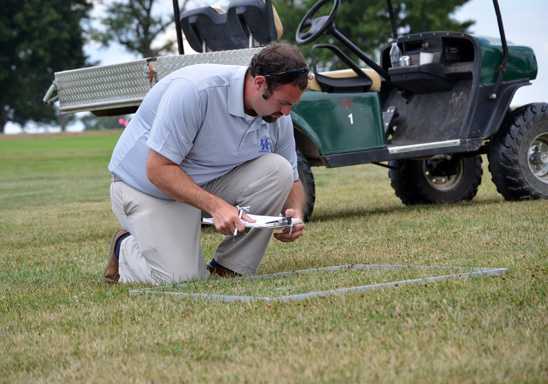UK researchers studying environmental impacts of lawns
UK researchers studying environmental impacts of lawns

Many homeowners love the sight of a pristine, green lawn, but that beautiful, meticulously kept lawn may come at a cost to the environment. University of Kentucky scientists are conducting research to find the answer.
UK turfgrass doctoral student Kenneth Cropper and David Williams, UK turfgrass professor, are measuring the carbon emissions and inputs of four different lawn management styles. Two systems are comprised of Kentucky bluegrass and tall fescue managed by a professional lawn care company. These sites are irrigated, fertilized and have pesticides applied. The third trial consists of zoysiagrass, a low-maintenance, warm-season grass that is a common lawn grass farther south but hardy enough for Kentucky. The fourth is a low-maintenance plot with a mixture of grasses and plants commonly found in residential lawns in Kentucky.
“Turfgrass systems do sequester quite a bit of carbon,” said Cropper, a student in the UK College of Agriculture, Food and Environment. “The big question is are the professionally maintained systems able to store more carbon in the ground than a low-maintenance lawn system.”
Systems that are intensively or professionally maintained release more carbon in the atmosphere due to their inputs. Cropper said common culprits in high-maintenance lawn systems include increased carbon emissions from lawnmowers and fertilizer and pesticide applicators, and the equipment that transports them to the site. Excess carbon in the atmosphere traps heat and leads to climate change.
“We’re looking for a balance,” he said. “Do homeowners really gain more carbon sequestration from putting all that extra effort into a high-maintenance lawn or are low-maintenance systems storing way more carbon?”
Cropper collects and analyzes soil samples for the amount of carbon and nitrogen in the soil. He then compares them to the carbon emissions required to maintain each particular system.
The study is in its third year, but researchers need at least two to seven more years before hard data is available, as it takes the inputs quite a while to influence the soil environment.
At the end of the project, UK researchers hope to develop recommendations for Kentucky homeowners who want environmentally friendly lawns.
Entomology Horticulture Research



